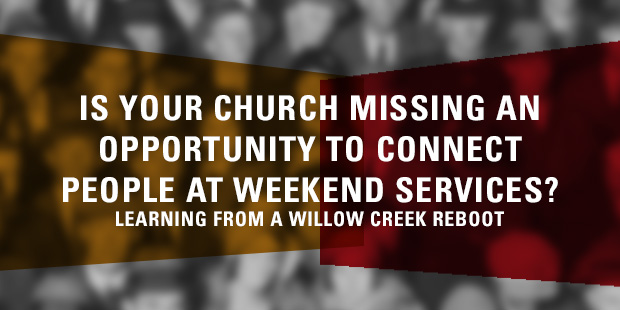
Is Your Church Missing an Opportunity to Connect People at Weekend Services? Learning from a Willow Creek Reboot
I sat in on a meeting at Willow Creek recently while Bill Hybels was casting some vision for the church’s new connection strategy…helping people find a place of friendship based on where they sit on weekends, then inviting them to connection events and gatherings.
It is not a new strategy; many of you have used this for decades with a twist or two in the method. And some of you will remember we taught this for years to group life to point leaders, encouraging them to “Leverage Your Auditorium” as a strategic step for connection. But some churches are still missing an opportunity to connect people at weekend services.
While this remains an “attractional” strategy (connecting people who come to the campus versus going into the community), it is a ripe opportunity each church has to connect with people who are already sitting there.
As I listened to the talk (1 of 4 vision Bill is doing for core leader teams) I had a flashback to my arrival to Willow in 1992. We were laser-focused on making disciples as the central part of our mission at that time. There was much fruit in those days that came from the hard work of hundreds of disciple-makers led by Mark Weinert, Don Cousins, Judson Poling, and many others using a group-based discipleship model. It was a whole-team effort with a clear strategy to support it.
Our challenge was how to get more people into the process and make group life more accessible for those who had trouble finding a group. So we focused on the one thing you absolutely must do in disciple-making: connection. As we wrestled with the right wording for building a church filled with group life, our team leader asked: “What is our infinitive? To grow…to disciple…to reach…to develop? What is it? How will it be your mission focus? Because it will become the central purpose of our mission in the first phase.”
What is your infinitive? What a great question!
After much discussion we made a decision. Our infinitive would be…
“TO CONNECT.”
Why? Because you cannot make committed disciples without connection. You can certainly try. Especially if you have a definition of “connection” that is less than personal and relational. Yes, there are non-relational strategies used in closed or persecuted countries, but you can bet there is not one follower in these countries who thrives by being alone. Discipleship requires People-ship. (A word from the Donahue Lectionary of Community-building!).
Our mission for the group life ministry at Willow in 1992:
To connect people relationally in groups of 4-10 people for the purpose of growing in Christlikeness, loving one another, and contributing to the work of the church, in order to glorify God and make disciples of all nations.
I did not hunt through old folders to look that up. I did not need to…I have it memorized, ingrained in my head from the beginning. TO CONNECT.
If you do not connect people, you cannot disciple people. Period.
…and he chose the 12 that they might be WITH HIM and that he might send them out to preach… (Mark 3:14)
So today…21 years later…Willow Creek is re-focused on a workable connection strategy so that people who arrive unconnected can find a relationship. Such a strategy must be about more than just filling seats at services. There must be an overall disciple-making strategy, equipped leadership, empowered people based on gifts (not just ministry slots to fill on campus), and movement beyond a come-and-see outreach focus to a missional go-and-serve/love/gather strategy off-campus.
You need a comprehensive approach, and I can help you process that change if you want to chat about that.
Remember: You cannot stop at connection…but you cannot start without connection.
To reach out to the many disconnected, pass-through people (visiting a couple weeks and out the door a few weeks later), it will provide an essential first step along the path.
What are you doing to leverage your auditorium or worship center for connection? Do people feel welcome, known, and cared for during their weekend experience at a service?
Read more from Bill here.

Tags: Bill Donahue, Connection, Strategy, Worship











